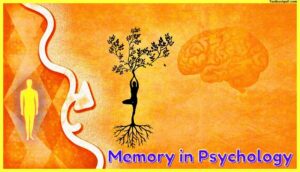Memory in Psychology (Part-2)
In this article we will talk about, Memory in Psychology, Short term memory, the Capacity of short-term memory, and Memory decay by proactive interference. We will also learn experiments in chunking, how information is coded in visual and auditory short-term memory and semantic coding in short-term memory.
In the last few articles, we have been talking about memory in the last article we talked about what memory means, how is memory important in a cognitive function how memory helps us get this sense of continuity of life get, and how memory really acts as a glue for all our sensory and sensory experiences all the things that we are we want to retain over a period of time in our lives we ended the last article talking about sensory memory which is one of the important components of memory as proposed by Atkinson and Shiffrin in their modal model of memory.
Short-Term Memory
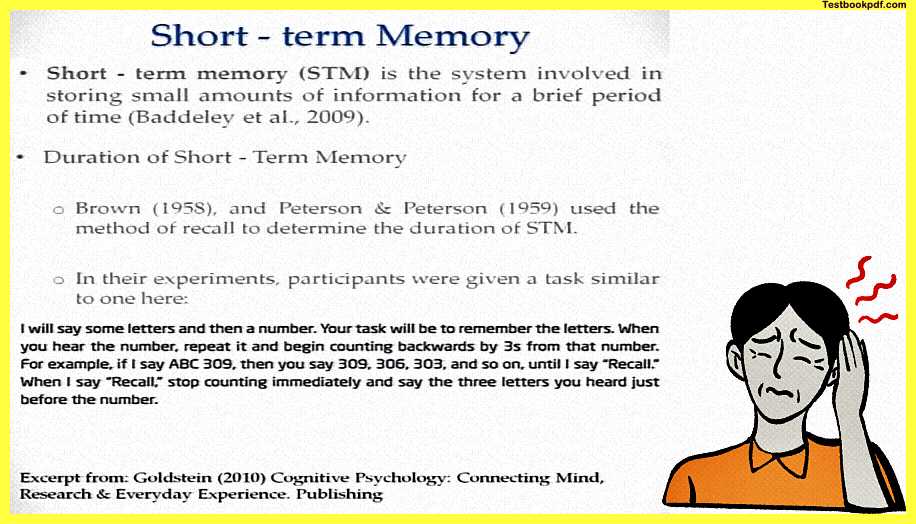
In today’s article, we will focus on something called short-term memory and we will try and see what short-term memory is and how we deal with short-term memory.
Now short-term memory is the system involved in storing small amounts of information for a brief period of time that is how badly defines it. Now badly says that short-term memory is basically about two things small amounts of information and also small amounts of time why would you need these kinds of small amounts of information and how will that be useful for it so anything you are doing?
For example, if you are doing some arithmetic calculation mentally you would need just the two numbers, and whatever operation you are doing this is relatively smaller information, and once you have successfully let us say multiplied or divided or added something that information is not useful anymore you just take the result and you move ahead with this.
So this is how or say for example let me take another example if you are hearing somebody or say for example if I am talking to you or you are listening to me the beginning of the sentence which I am saying remains there for a very short time after that it is just it out and you just remember the gist of the entire message so those are some scenarios wherein shorter memory can be very useful shorter memory is basically like the ram of your system wherein all the things that you’re doing all the things you’re currently involved in everything that is in the present is there in the short-term memory because you’re drawing constantly from the long-term memory using that information that you’ve drawn from the long-term memory and after using that performing some operation in the short-term memory you let it go again back to the long-term memory so that is
- What the importance of short-term memory is now?
- What is the duration of short-term memory?
So brown Peterson and Peterson use the method of recall to determine what does the duration of short-term memory so what they did was in their experiments participants were given a very similar task the one I am going to demonstrate to you so say for example I could tell you that I will say some letters then I will say a number.
Now whatever letters I say your task will be to remember the letters when you hear the number however repeat it and then begin counting backward by threes so from that number say for example if I say ABC 309 then you already start counting – 3, 0, 9, 3, 0, 6, 3, 0, 3, 3, 0, 0, 2, 9, 7 and so on until I say recall as I am saying recall you have to stop counting immediately and say the three letters you have heard just before that number.
All trails
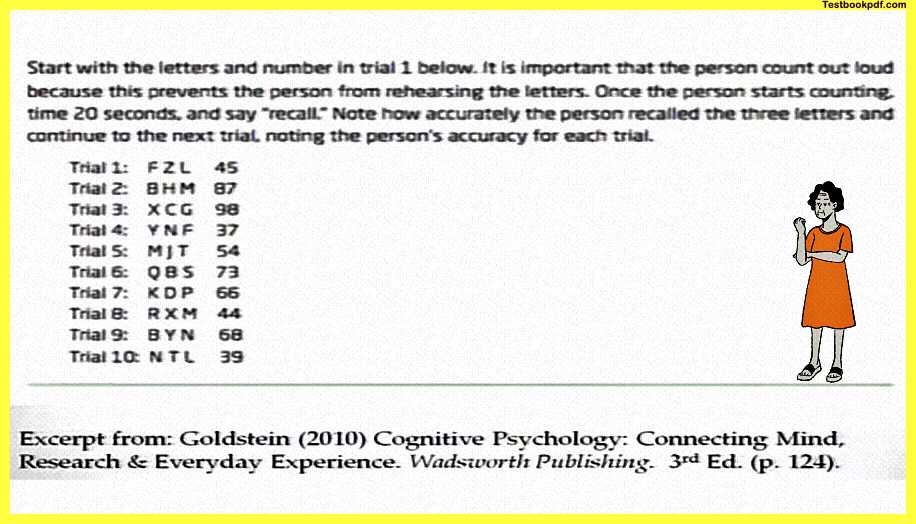
So this is something which you can do it very easily so if I say ABC 506 then you can kind of start talking backward and then I say after some time recall and you have to say which thing you did you have to constantly keep counting and constantly I will say some letters to you this is the whole demonstration so in the first try I could say let us say scl 45 trial 2 I could say something else and you can keep counting and there could be different digits so this was the overall thing to actually administer it if you want to do it with one of your friends what you have to do is it is important that the person counts out allowed.
So he is constantly counting at the top of his voice so that he is not rehearsing the letters the second most important part is once the person is started counting you kind of take around 20 seconds and then you say recall and then what you do is remember you accurately say for example see how much information what are the three letters the person has remembered accurately and before he continues with the next trial now peters and Peterson also did a similar experiment in which they varied the time between they said the number and when the participant began recalling them so they kind of tried to vary the time between the recall signal comes and the number is there now Peterson and Peterson they found that their participants were able to remember around eighty percent of the letters after counting for three seconds.
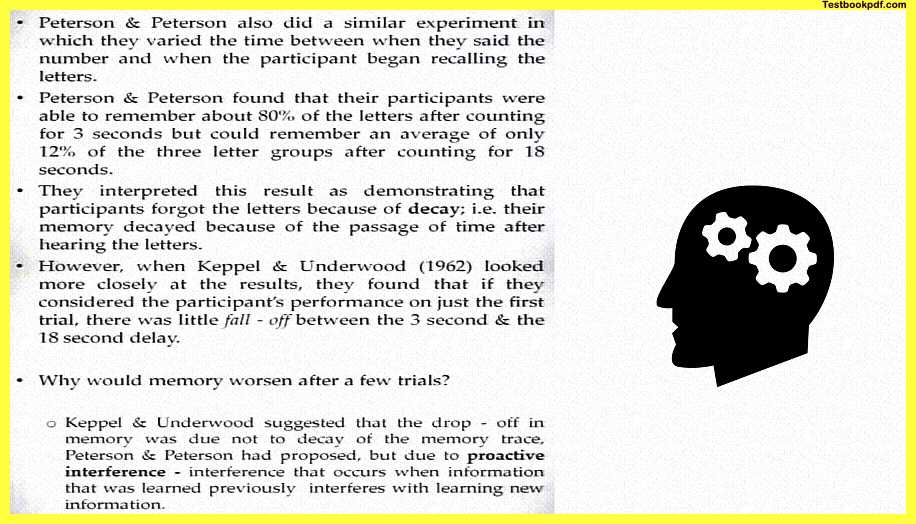
So after counting for three seconds their memory is intact they are doing very well they are remembering around eighty percent of these letter sequences that have been told but if they increase the time for which they have said recall by 15 more seconds the participants could remember on an average of only 12 percent of the three-letter groups so they have to constantly keep remembering all those letter groups that you have said now Peterson Peterson interpreted this result as demonstrating that participants are forgetting the letters because of the decay so they are maintaining the letters but the time gap you give between saying recall and between saying the first sequence of letters as long as this time gadget is increasing the memory for those letters is decaying of because you have to constantly maintain the letters which I am saying you still have to do the counting but you to maintain the letters which I am saying.
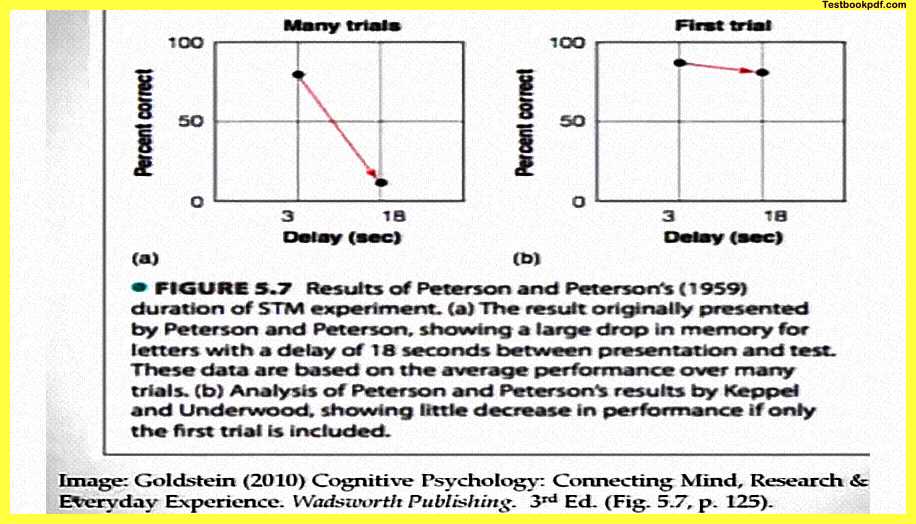
Now, this is what they say memory is decaying because of the passage of time after hearing the first sequence of letters Keppel and Underwood. later at a later point in time, they actually looked more closely at the results that Peterson and Peterson reported and they found that if you consider the participant’s performance very closely and on just the first trial there is a little fall-off between the three-second and the eighteen second if you’re just talking about the first I’ll say for example if I have said abc309 now abc309 after three seconds and abc3309 after 18 seconds there is very little fall off for this amount now why should the information why should the memory for this is getting worsened up after a few trials are it just time or something is happening.
Now Keppel and underwood suggested that the drop off in memory was due to the decay of the memory trace peter and Peterson Peterson and Peterson had proposed it’s not due to just the decay of the memories trace but it is due to proactive interference
What is proactive interference?
Proactive interference is that interference that occurs when information that was learned previously interferes with the learning of new information so as soon as i am adding on the sequences of letters you are kind of finding it more difficult to remember those sequences of letters that is what is happening ok so it’s not only time but it is built up of information that is leading to this decay and leading to this inaccuracy in performance here you can see the results.
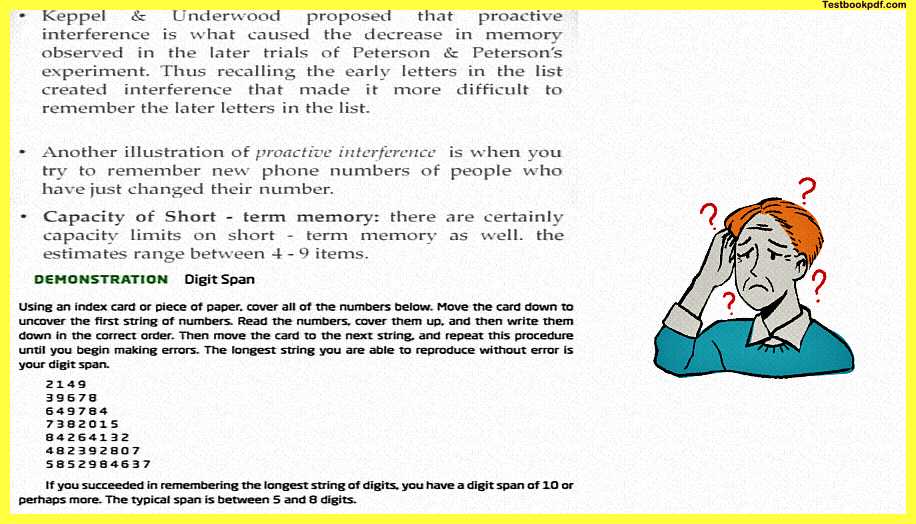
So if you see the three-second delay and the 18-second delay on all the trials you see that the performance kind of dips off significantly but if you are just taking the first trial in mind you see even on the 18-second delay the performance is not veered off very significantly now Keppel and underwood they propose that proactive interference is what caused the decrease in memory observed in the later trials of Peterson and Peterson’s experiment thus recalling the early letters in the list created interference that made it more difficult to recall the later letters you might have also seen this happening with you say for example if I give you my mobile phone number and five days later 10 days later i tell you that my phone number has changed it might actually make it difficult for you to remember which is my correct number.
Nowadays it does not really happen because you will update your cell phone with the new information but suppose if you were to remember this information and i keep giving you new information say for example it is my address so i give you a one address and i ask you to come to my home next time i kind of change the address and i give you another address and expect you to remember that what will happen is obviously sometime you will kind of confuse which is the address i am living on basically my earlier address will make it difficult for you to remember my later and more recent addresses that is typical example of proactive interference and there are many ways you will find this happening now let us we have talked about the duration of short term memory now let us talk about the capacity of short term memory now there are certainly capacity limits on short-term memory as well the estimate ranges between around four to nine items so there have been different kinds of estimates made and they say that is just around four to nine items.
Magical Numbers
Now we have in the earlier class talked about short-term memory has a very small capacity to store for a very small amount of time but it is is it as short as four or nine items only how do you remember other information if you really want to check somebody’s short term memory capacity what you could do is you could use this demonstration from Goldstein’s book on cognitive psychology what you just have to do is you can just write the first sequence of three letters then add one more letter add ask them to recall a sequence of four letters or digits maybe you can do it.
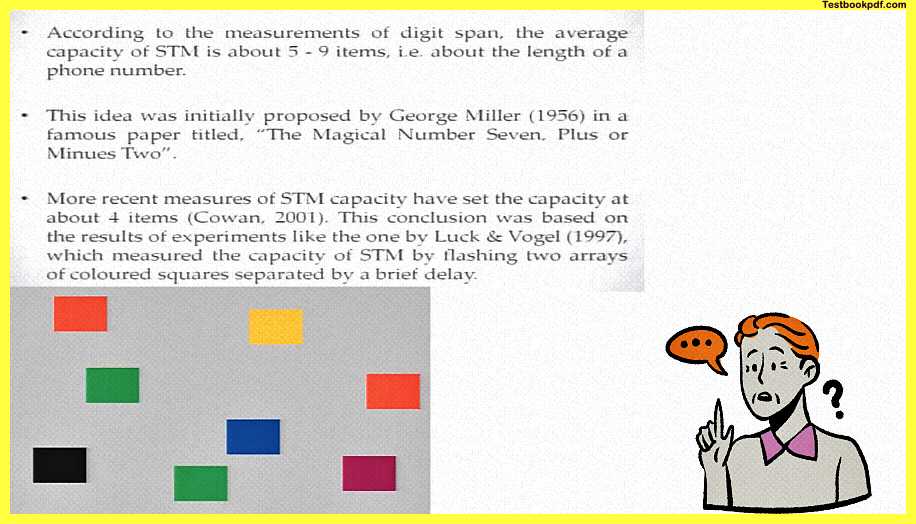
So three digits four digits five digits six digits and you have to ask the person to repeat that digits back to you without making any errors and doing it in a particular order according to the measurements of digit span the average capacity of the short-term memory is somewhere around five to nine items that are basically about the length of a phone number now this idea was initially proposed by George miller in 1956 when he wrote a very significant and very important paper called the magical number seven plus or minus two so you are saying the size or the capacity of the shorter memory is around seven plus minus two items more recent measures of short-term memory capacity, however, have set the capacity limit to be about around four items this is a more recent thing found in the work of coven in two thousand one.
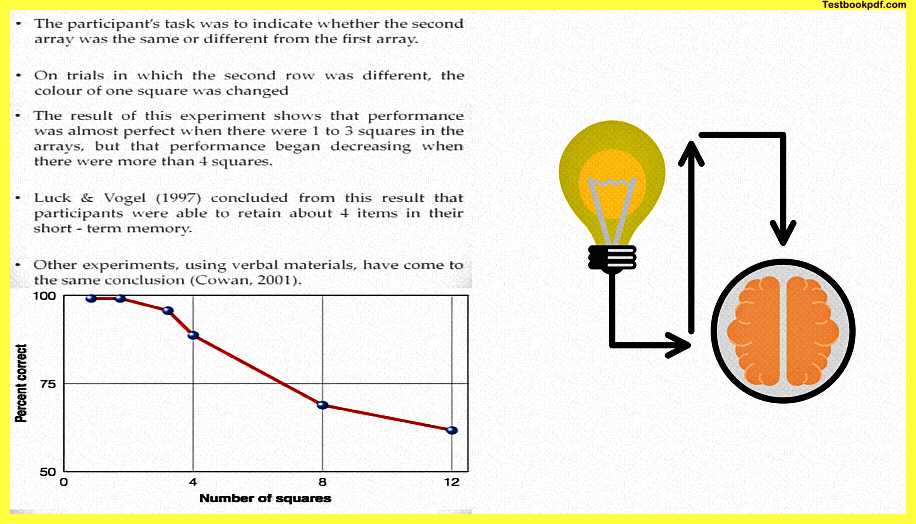
Now this conclusion was basically based on the results of experiments like the one done by luck and vogel in 1997 in which they are measuring the capacity of the short-term memory by flashing two arrays of colored squares separated by a brief delay and then they kind of say how many squares they correctly remember so i will show you this in a demonstration say for example you see this array of squares and then there is a gap and you see this other area of squares what you have to do is you have to judge whether the second area of squares has the all the same element as the first area of squares so participants task here was to basically indicate whether the second array was the same or different from the first array and on the trials in which the second row was different a second array was different the color of one square was only changed so you kind of have to be really attentive and check which square has changed its color maybe you can do this again so here is the array the short delay here is another array did you recall did you make out which color which square color was changed.
Now the result of this experiment showed that the performance was almost perfect till there were 1 to 3 squares in that array but the performance gradually and steadily began to decrease when they started adding more than four squares so luck and Vogel concluded from this result that participants were able to retain only up to about four items in their short term memory other experiments using verbal materials have also come to the round the same conclusion you can see this result of luck and vocals experiment here you see as the number of squares is increasing from 1 to 3 to 4 to 8 to 12 the performance is steadily and significantly declining but force seems too less isn’t it as I was saying earlier as well 4 seems too less information to be able that we can recall that we can retain.
So how do we store so much information even in a short-term memory say for example if you have to recall my phone number which has ten digits it is certainly ten digits and not just four numbers ok how do you do that how do we say for example if there is a long sentence we have to remember how do we remember that long sentence these kinds of questions can be asked and let us see in the later things how do we do it, we do it by using a particular phenomenon called chunking.
So miller in 1956 introduced the concept of what is called chunking to describe the fact that small units like words can be combined to make larger more meaningful units like phrases or even larger units like sentences paragraphs or stories say for example if I give you this list of words monkey child widely? so widely zoo jumped city ringtail young there are eight or nine words and if I ask they ask you to repeat them very quickly or let us say if I ask you to repeat them in pairs ringtail monkey jumped widely young child cities maybe this is slightly easier than the earlier disorganized array of words if I organize it even better the ringtail monkey jumped widely for the young child at the zoo is better remembered as compared to the first one.
So what is it that is happening in these three examples what is it that is changing what is changing is the organization of the information into groups or chunks and what you are doing is you are kind of remembering a chunk as a whole so if you see at the last sentence it has exactly the same number of words it has all the words that I said in the first example but now it has a structure to it it has an organization to it and what you will remember is the gist of what this message was and you can kind of reconstruct from that just the sentence that I will ask you to repeat if I gave you eight or nine separate and unorganized words in the first way in the first level you found it difficult to repeat so that is pretty much what we are doing let me also do will do some simple demonstration here say for example try and recall these letters there is a gap could you recall everyone?
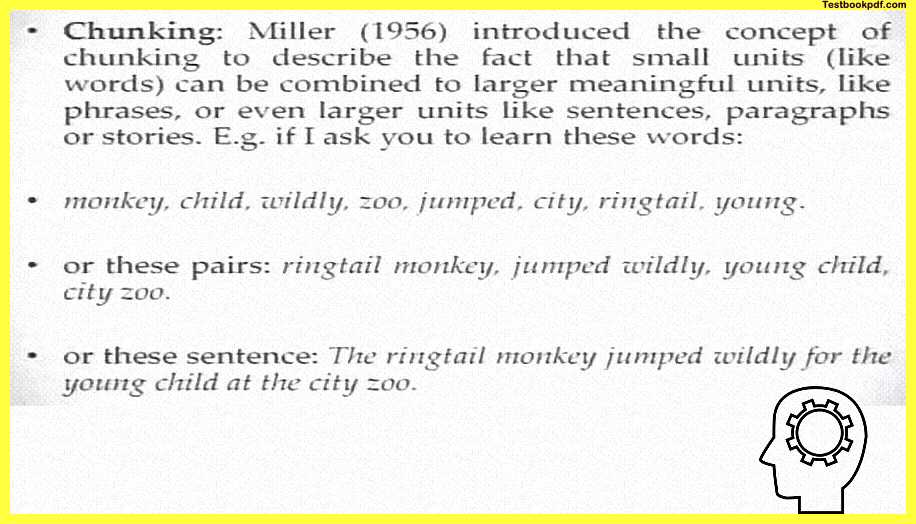
For example, now you try and recall this letter which one was easier I have seen in class demonstrations and I hope with you as well that this congregation of letters is easier to remember because these are names or abbreviations so you can actually organize them into CIA FBI NBC and CBS so there are only four chunks if you organize them accordingly and that is what chunking is all about so let me define chunking for you slightly in a more formal way.
Definition of chunking
So chunking has been defined as a collection of elements that are strongly associated with one another but are weakly associated with other elements in chunks with elements in the other chunks so you can have units working together and distinctive or distinguishable from other units so you can have ringtail monkey but if you have a ringtail child that will not make the association very well.
So if there is ring tale monkey coming together you will remember it much better Eriksen and colleagues demonstrated the effect of chunking by showing how a college student with average memory ability was able to achieve amazing feats of memory so they trained this kid in their participant was named SF and he had a typical memory span like all of us of 7 digits but he received extensive training for about 231-hour sessions and then he was able to repeat sequences up to 79 digits without making an error how was SF doing that obviously SF was using chunking to recode the digits into larger units and formed that forms slightly meaningful sequences say for example three four nine two became two minutes and 49 0.2 seconds or 3 minutes and 49.2 seconds.
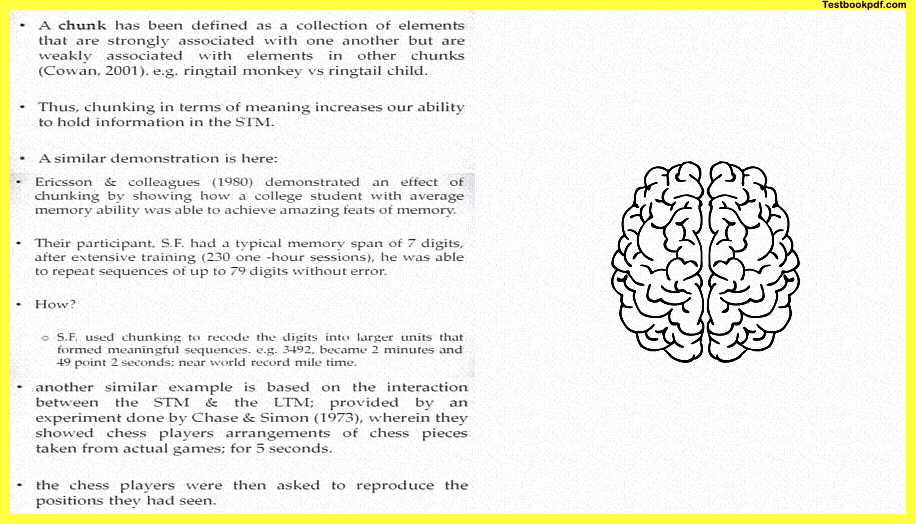
Now, this is a way if you kind of remembers this, this kind of can become a way or a cue to remember this information in a more meaningful way and in that sense this can be basically used to enhance your memory so a very simple tip will be for people who want to improve their memory having done a course on cognitive psychology and read something about memory so start organizing information better start storing information in ways that are meaningful to you and so that those meaningful ways can be queued with very little effort now coming back another similar example is based on the interaction between the short-term memory and the long-term memory and it was provided by an experiment done by chase and Simon in 1973 wherein what they did was they showed chess players arrangements of chess pieces taken from actual games for 5 seconds.
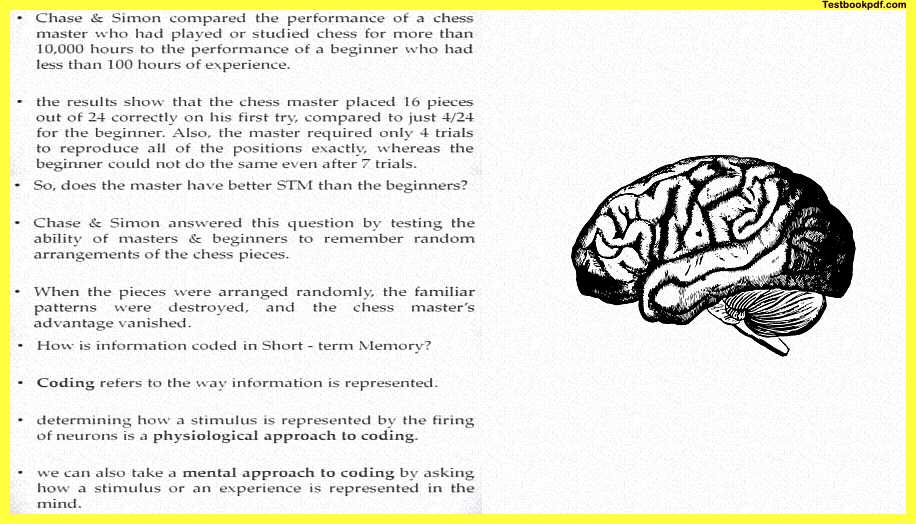
So chess players and the novice person who had never played chess were shown arrangements of 24 pieces or 24 chess pieces on a particular board and then they were later asked to recall which were the pieces so the chess players basically were asked to reproduce their positions and the position that they had seen and it was like the chess and the chase and Simon compared this performance of a chess master who had played or studied chess for around ten thousand hours to this performance of a beginner who had only who had around less than hundred hours of experience now the results of this particular experiment showed that the chess master had placed 16 pieces out of 24 pieces correctly on his first try itself compared to 4 out of 24 pieces that the beginner person could do also the master required only 4 trials to reproduce all of the 24 pieces correctly as compared to the beginner who could not even do the same even after 7 trials.
So you see there is something here now is it that the chess player is an expert so here is the data so the master around does this correct placement 16 correct placements on the first trial itself beginner does only four so does the master have better shorter memory than the beginner or does he have better knowledge of chess is that helping him in some way or the other that was the question that was asked Simon and chase they answered this question by testing the ability of the masters and the beginners to remember the random arrangement of chess pieces.
So if you have played chess if you are familiar with chess if you have arranged something in a particular way you will know that there are specific positions and there is a specific name for each position so if you are a chess master you can recall those positions by experience and you can say that but when you are actually looking at randomly arranged pieces there is no name for those kinds of positions and then let us see what happened when the pieces were arranged randomly the familiar patterns were destroyed and the chess masters advantage completely vanished.
So it was not that his shorter memory was better it was that he knew those familiar positions from obviously a lot of practice and skill that is acquired over ten thousand hours of chess training and that was what was helping him organize those positions better there were names of those positions and that he could have used to organize that so you see here there is no advantage for the master if he cannot chunk on the basis of previous knowledge that is pretty much what we all do if we are fed in new information now how do you feed in new information in short-term memory that is the third question one can ask you feed in new information into the short term memory by a process called coding or a process called encoding, now determining how stimulus is represented in the brain by firing of specific neurons as was seen by Dublin weasel as i mentioned in one of the earlier articles is called the physiological approach to coding that is one way to do it the other way to do it all is following the mental approach to coding
What is the mental approach to coding?
the mental approach to coding is by asking how a stimulus or an experience is represented in the mind.
For example, if you go somewhere and you meet some new person and you just have a short conversation with him you come back and you’re trying to recall that person maybe there’s something similar something salient about that person maybe that he belonged to a city where you had done your previous cooling if you remember that person according to that knowledge it might help you recall better now similar things you could use in chunking as well so there could be a variety of ways in which one can encode information the first kind of way is auditory encoding, auditory encoding involves representing items in the short term memory based on their sound.
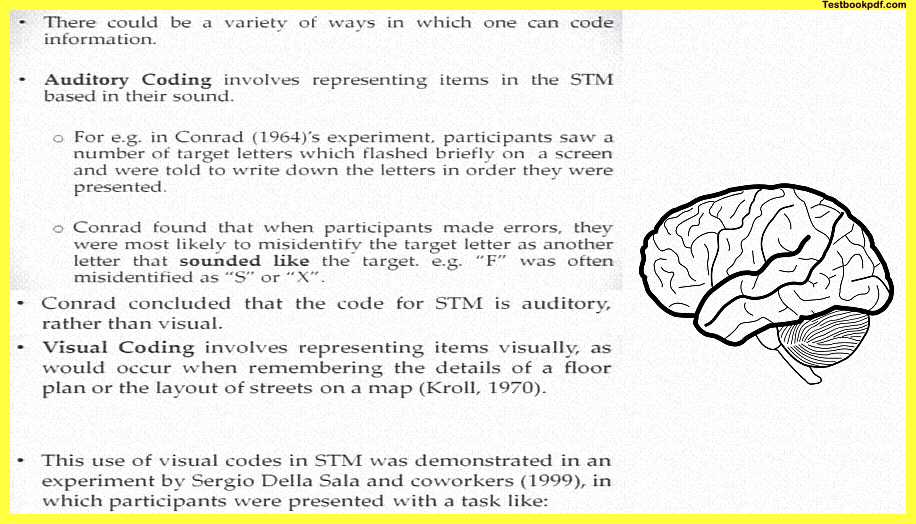
So what Conrad did in his 1964 experiment was he showed participants a number of target letters which flashed very briefly on a screen and then the participants were told to write down the letters in the order in the exact order they were present now Conrad found that when participants made errors they did make some errors though when participants made errors they were most likely to misidentify the target letters as another letter if they sounded very similar.
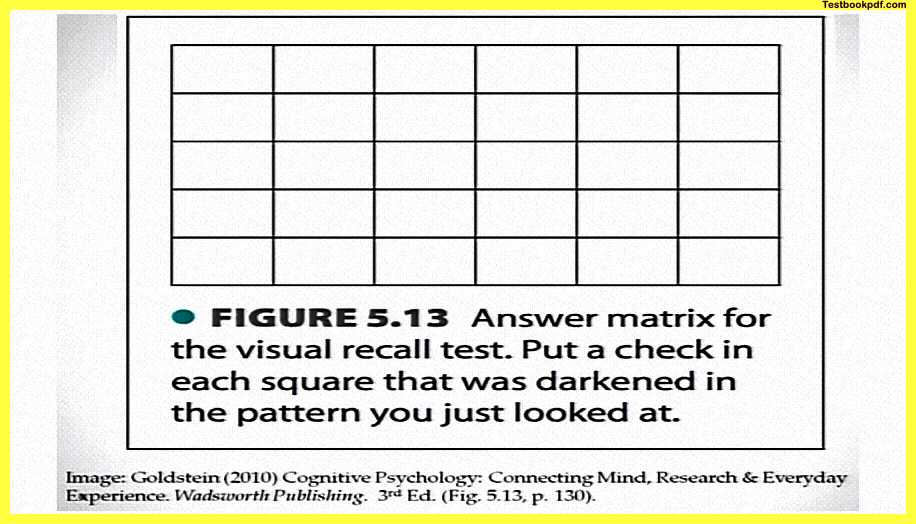
So if they sounded very similar there was a scope of confusing them say for example a lot of participants were misidentified f as s because they sound so similar to each other Conrad concluded on the basis of this these results that the code for STM is the or the preferred encoding method for STM or short-term memory is auditory rather than visual now it is not that we do not encode visual information or it is not that we do not encode information in a visual manner we also do encode items and information in a visual manner and visual encoding basically involves representing items visually.
For example, this would occur if you’re trying to remember the details of a floor plan or a blueprint of a particular building something like that, or the layout of a street on a map if you’re dealing with specific visual information that does is not really easily encoded in the verbal thing you will use it visually as well now this use of visual quotes in the short term memory was demonstrated in an experiment by Sergio Della Sala and their colleagues in 1999 in which participants have presented a task like this one here so I will show you this array of squares some of them are blocked and then I will ask you to fill exactly which squares are black in this particular experiment now both of these demonstrations are drawn from Goldstein’s book and gone in psychology now de la salle in this experiment found that participants were able to complete patterns consisting of an average of around nine shaded squares before they started making mistakes.
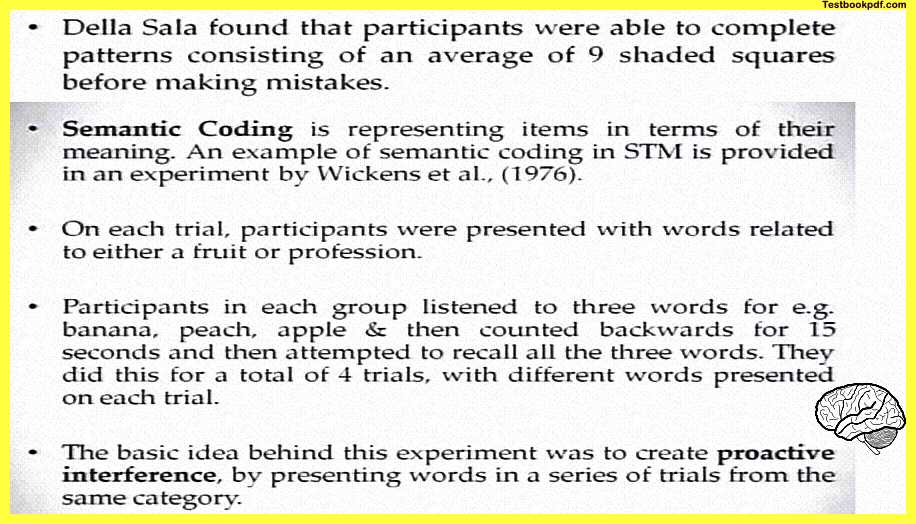
So up till nine squares they could correctly remember but they started making mistakes if the number of squares was more than nine another way of coding information other than auditory and other than visual is basically starting to code information on the basis of semantics on the basis of their meaning and their relationship to whatever knowledge you already have something that i was telling now semantic coding is representing items in terms of their meaning an example of semantic coding in STM is provided in an experiment done by Vikings and colleagues and in this experiment what happened was that on each trial participants were presented with words related to either a fruit or profit so there were two groups they were presented items say names of fruits and other group was presented names of professions so participants in each group they were listening to three words for example banana peach and apple and then started counting backwards for 15 seconds and then attempted to recall all the three words now they did this for a total of four tiles and with different words presented on Esha.
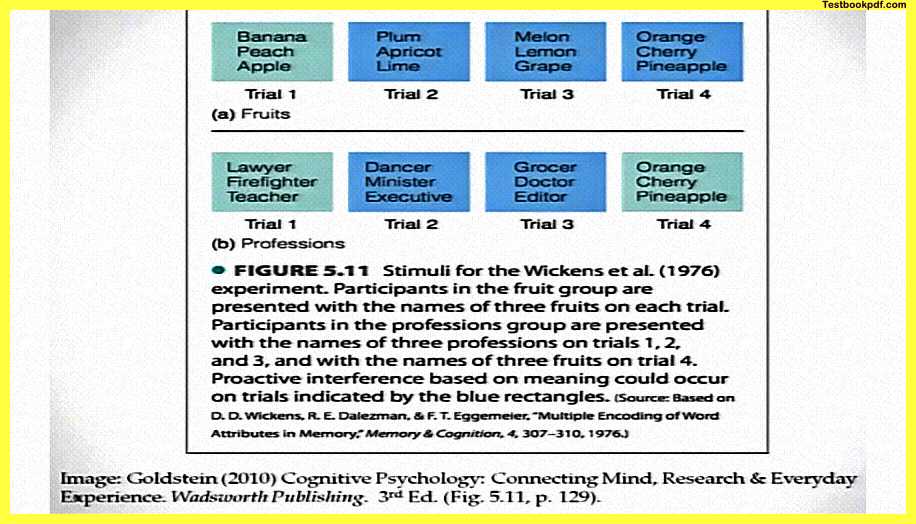
So every tile they will say for example see some names of fruits then they’ll start countering backward and they’ll be told another three fruits and they’ll start counting and they’ll continue counting backward but they do remember all of this now the basic idea behind this experiment was to create what is called proactive interference by presenting words in a series of trials from the same category so if you are repeating the same kind of words trial by trial these new trials will actually interfere with the older trials I will show you a demonstration say for example you can see in a trial in the fruits group the first trial is banana peach and apple the second trial is plum apricot and lime the third trial is melon lemon and grape the four trial is orange cherry and pineapple.
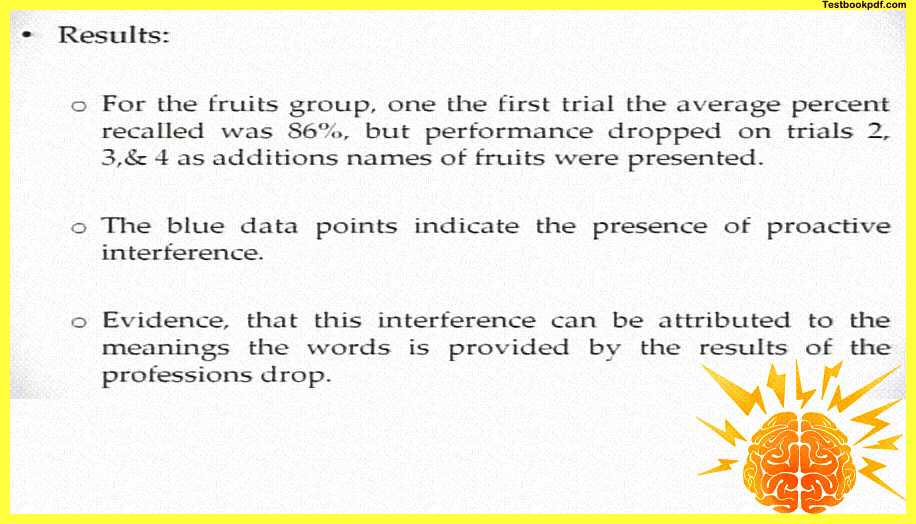
So the fruits group is basically getting all of these fruit names the second group is the professions group and they are also being said these profession names only on the fourth trial they are not told a profession’s name they are actually told a fruit’s name there are three names of fruit so first aid is lawyer firefighter teacher second is dancer minister executive grosser doctor editor the fourth one is the name of three fruits.
Now, what do you think happened here now it was found that for the fruits group on the first trial the average percentage recall was as high as 86 percent but performance dropped gradually and steadily on trials two three, and four as additional names of fruits were being presented.
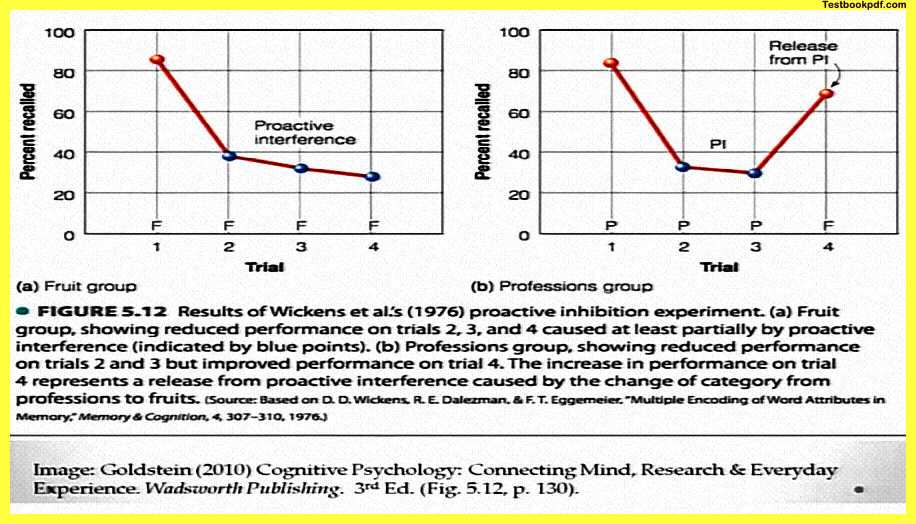
Now this additional information forms part of the same category of the first trial and in that sense, there is proactive interference starting from the second trial third trial, and fourth trial the blue data points I will show you now indicate that the presence of proactive interference is there if you see in this figure here on the fourth on the professional group what happened was that because the fourth trial had names of fruits instead of professions there is no proactive interference there is what is called release from proactive interference that is where the performance of recall on the four trial is also very good.
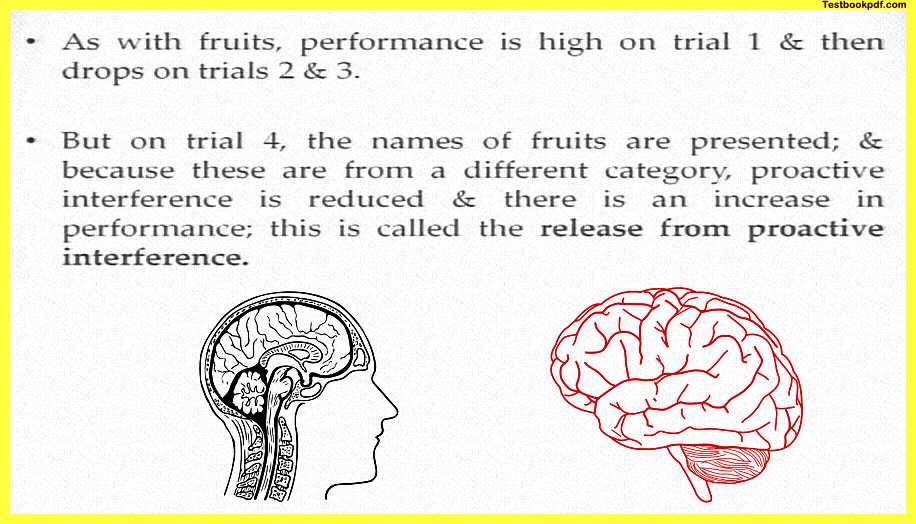
So you can see here in this particular result that in the fruits group you will see that the performance is steadily and gradually declining from trial 1 to trial 2, 3 and 4. in the professions group you will see that the performance is very good on the first trial it comes down on the second trials goes further down on the third trial but on the four trial there is already a release the performance of the partition already kicks up and this is and why is this happening is because the things presented the names presented on the fourth trial were different from all the names presented in trials one two and three so these phenomena is basically referred to as release from proactive interference because the four trial had names from different category participants had no trouble in recalling this new information and their performance increased and it became better.
Now, these were some aspects of short-term memory that we studied today we talked about the duration of short-term memory we talked about the capacity of short-term memory and we also talked about different ways in which information can be encoded into short-term memory I hope this session on short-term memory would help you understand more about memory as a mental function in the next chapter we will talk about other aspects of memory that were proposed by Atkinson and Shiffrin thank you so much.
Read also:
